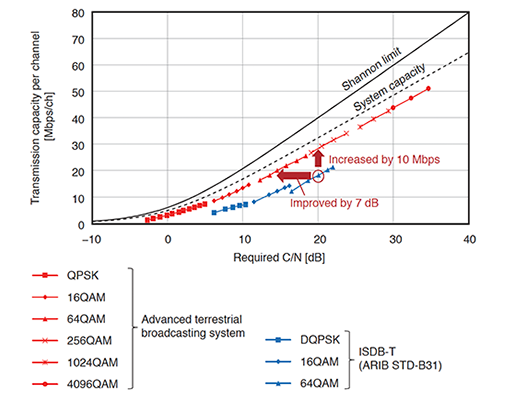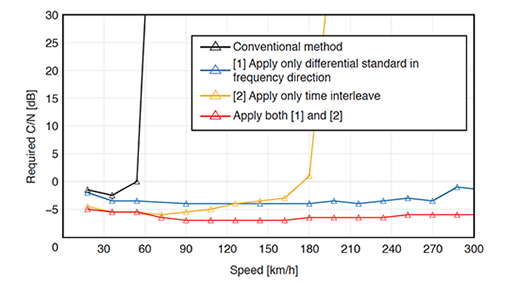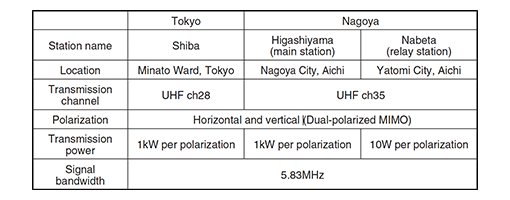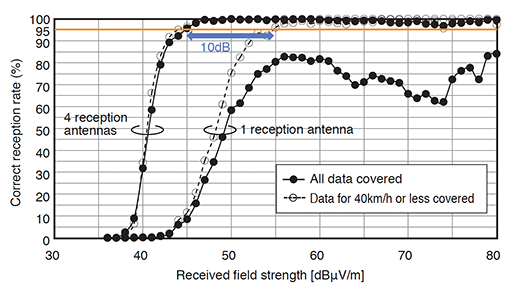Research Area
2.8 Terrestrial broadcasting transmission technology
For the terrestrial broadcasting of 4K/8K, we made progress in our research on an advanced terrestrial broadcasting system by evaluating its characteristics, making improvements and conducting large-scale field experiments. We also conducted R&D on time-division multiplexing (TDM) and other systems that are different from the advanced system using frequency-division multiplexing (FDM), which we have been studying, and worked with international organizations in efforts such as investigation on the use of the fifth-generation mobile communications system (5G) for broadcasting. Part of this research was being performed under the auspices of the Ministry of Internal Affairs and Communications, Japan as part of its program titled "Research and Development for Advanced Digital Terrestrial Television Broadcasting System," in cooperation with Sony Corporation, Panasonic Corporation, Tokyo University of Science and NHK Integrated Technology Inc.
■Evaluation of characteristics of advanced terrestrial broadcasting system and technology for their improvement
In FY 2018, we evaluated the characteristics of the advanced terrestrial broadcasting system through laboratory experiments using a modulator and demodulator that we prototyped in FY 2017. We demonstrated that the advanced system, which has more robustness by using Low-Density Parity-Check (LDPC) codes and a non-uniform constellation and a larger transmission capacity by having a new signal structure, can increase the transmission capacity by about 10 Mbps compared with ISDB-T, the current standard for digital terrestrial broadcasting, when the required C/N is the same while it can reduce the required C/N by about 7 dB when the transmission capacity is the same(1) (Figure 2-18). Moreover, the results of laboratory experiments simulating an actual SFN environment showed that the advanced system can reduce the degradation in the required C/N caused by an SFN by about 2.7 dB from that of ISDB-T(2).
We also worked to improve the advanced terrestrial broadcasting system that we previously formulated. In FY 2018, we devised a method for increasing the transmission robustness of transmission and multiplexing configuration and control (TMCC) signals, which are transmission control signals, evaluated the method through computer simulations and implemented it into hardware. The conventional TMCC signal transmission used differential BPSK (Binary Phase Shift Keying) as the carrier modulation scheme and used signals adjoining in the time direction as differential reference signals. Our proposed method reduced the performance degradation caused by the time variations of the channel by using signals adjoining in the frequency direction as differential reference signals. In addition, we applied a cyclic shift to TMCC signals in the time direction only for the amount of shift determined based on the segment number to obtain the time interleave effect. We confirmed that the use of these two elemental technologies improved speed tolerance in a mobile reception environment(3) (Figure 2-19).
We also evaluated the effect of cyclic-shift frequency interleave, which we proposed as a technology for improving the performance of data signal transmission, through laboratory experiments. The conventional method needed to use two different types of frequency interleave depending on the scattered pilot (SP) signal configuration between layers, but the evaluation results demonstrated that our proposed method can replace the two types of frequency interleave with one type while ensuring the same level of reception characteristics.

Figure 2-18. Relationship between required C/N and transmission capacity

Figure 2-19. Comparison of speed tolerance of TMCC signal transmission
■Other systems than advanced terrestrial broadcasting system
We conducted research on hierarchical transmissions using TDM and layered division multiplexing (LDM), which are used for broadcasting systems in Europe and the U.S. For TDM, we studied a synchronization algorithm and a transmission method for preamble signals, which are not used by FDM. We also prototyped a TDM modulator and demodulator that has the same sampling frequency and signal bandwidth as those of an FDM device for performance comparison between TDM and FDM. For LDM, we conducted laboratory experiments using a modulator and demodulator that we developed in FY 2017 to evaluate the mobile reception characteristics of the use of LDM for the partial reception layer of FDM. The results demonstrated its effectiveness(4). We also developed prototype modulator and demodulator that implement a gray mapped LDM which can improve characteristics when simultaneously demodulating multiple layers multiplexed by LDM.
We researched a wide-band terrestrial broadcasting system, which can improve interference tolerance by expanding the bandwidth and reducing the modulation level and the code rate of error correction code when we focus on ensuring a certain level of transmission capacity. We evaluated the tolerance to interference through computer simulations assuming a case that different programs are broadcast in neighboring broadcast areas. The results demonstrated that successful reception was achieved even if undesired waves with the same power as desired waves were received.
Table 2-1. Transmission specifications of experimental stations


Figure 2-20. Transmission antennas of experimental stations and experimental area guidelines

Figure 2-21. Effect of diversity reception
■ Preparation of experimental stations and field experiments for evaluating advanced terrestrial broadcasting system
As part of the government-commissioned project from the Ministry of Internal Affairs and Communications titled "R&D on Advanced Technologies for Terrestrial Television Broadcasting," in FY 2018, we constructed large-scale experimental environments in Tokyo and Nagoya (Table 2-1, Figure 2-20). We increased the transmission power in stages up to a specified level over a period of about one month while ensuring that radio waves from the experimental stations give no impact on existing wireless stations. Licenses were issued for the Higashiyama and Nabeta experimental stations in November 2018 and for the Shiba experimental station in December 2018. Following the issuance of the licenses, we began field experiments using a modulator and demodulator for the advanced system that we developed in FY 2017.
In Tokyo, advanced system signals transmitted from the Shiba experimental station were received by a reception antenna 10 m high. At the measurement point, we collected channel responses as well as electric field strength and bit error rate characteristics using our signal analysis equipment(5). We conducted measurements at 41 points and analyzed data such as the degradation of required received power due to multipath propagation and the received power ratio of horizontal polarization and vertical polarization. In Nagoya, we conducted SFN field experiments using the main station (Higashiyama) and the relay station (Nabeta). We measured the degradation of transmission characteristics, that is caused by SFN waves, by varying the desire and undesire received power ratio (D/U) and the delay time between the main station and relay station. At various measurement points, where the antenna direction between the main station and relay station are different, the results were compared with that of laboratory experiments. In addition, we conducted mobile reception experiments in Nagoya. We investigated electric field strength and evaluated reception performance by driving a measurement vehicle over a distance of about 350 km in the broadcast area of the Higashiyama experimental station(6). In our evaluation of diversity reception with a larger number of reception antennas, we found that the use of four reception antennas can reduce the impact of the degradation caused at a fast driving speed. We also confirmed that it can obtain diversity gains of 10 dB or more compared with the use of a single reception antenna (Figure 2-21).
■International collaboration
ITU-R WP6A (Terrestrial broadcasting delivery) is preparing a report on network planning and transmission methods for advanced digital terrestrial TV broadcasting. In FY 2018, we proposed adding information about dual-polarized multiple-input multiple-output (MIMO) for expanding transmission capacity, LDPC codes for enhancing transmission robustness and a non-uniform constellation.
Meetings of the Future of Broadcast Television (FOBTV), where broadcasters and standardization organizations around the world gather, were held at the venues of the NAB Show 2018 and IBC 2018. We attended the meetings to share the latest trends of next-generation broadcasting. We also investigated broadcast-broadband experiments over terrestrial broadcasting networks which the Electronics and Telecommunications Research Institute (ETRI) of South Korea conducted on Jeju Island in South Korea.
As part of activities at the Digital Broadcasting Experts Group (DiBEG) of ARIB, we exchanged opinions about next-generation terrestrial broadcasting with SBTVD-Forum, a standardization organization in Brazil.
As part of study toward next-generation terrestrial broadcasting, we are investigating the use of 5G for broadcasting in cooperation with EBU. In FY 2018, we attended the meetings of the 3rd Generation Partnership Project (3GPP), which is working on the standardization of 5G, to study the trends.
| [References] | |
| (1) | Y. Yamakami, et al.: "Performance Evaluation of Modulator and Demodulator for the Advanced Terrestrial Broadcasting (1) - AWGN performance -," ITE Annual Convention 2018, 33D-1 (2018) (in Japanese) |
| (2) | T. Ijiguchi, et al.: "Performance Evaluation of Modulator and Demodulator for the Proposed Specification of the Next Generation Terrestrial Broadcasting (2) - in SFN environment -," ITE Annual Convention 2018, 33D-2 (2018) (in Japanese) |
| (3) | H. Miyasaka, et al.: "A Study on the Robust Transmission of TMCC for the Proposed Specification of the Next Generation Terrestrial Broadcasting," ITE Tech. Rep., Vol.42, No.36, BCT2018-84, pp.69-72 (2018) (in Japanese) |
| (4) | A. Satou, et al.: "Laboratory experiments of hierarchal transmission system combinated FDM with LDM," ITE Annual Convention 2018, 21C-2 (2019) (in Japanese) |
| (5) | T. Ijiguchi, et al.: "Development of Signal Analysis Equipment for Advanced Digital Terrestrial TV Broadcasting System," ITE Tech. Rep., BCT2019-36 (2019) (in Japanese) |
| (6) | H. Miyasaka, et al.: "A Study on the Mobile reception for Advanced Digital Terrestrial TV Broadcasting System," IEICE Annual Convention 2019, B-5-117 (2019) (in Japanese) |